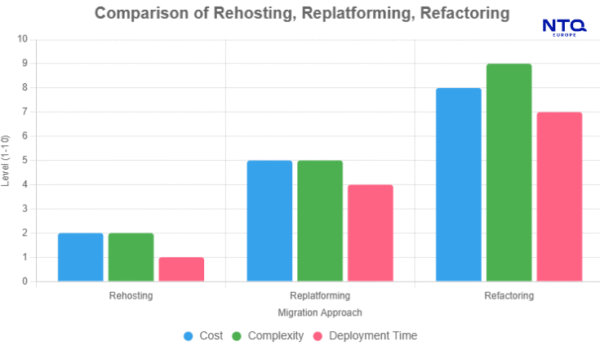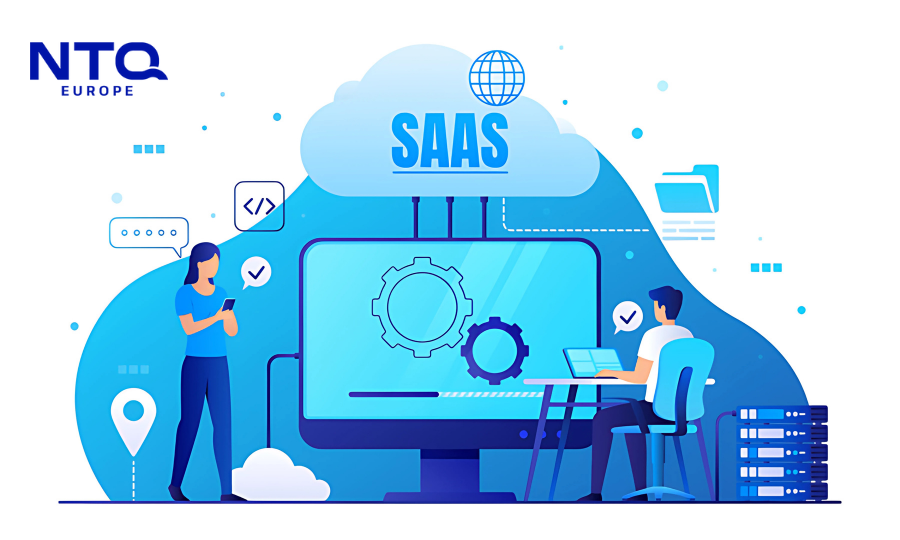In this two-part series, we’ll explore what makes Rehosting so appealing, when it makes sense, and how NTQ Europe helps companies adopt it successfully. We’ll also address key challenges, best practices, and how businesses can leverage Rehosting as a first step in a broader cloud journey.
1. Understanding Rehosting (Lift & Shift)
At its core, Rehosting, or Lift and Shift, is the process of moving applications from on-premises infrastructure to the cloud with minimal or no modifications. Instead of refactoring or rewriting code, organizations simply “lift” the application stack from its current environment and “shift” it to a cloud platform like AWS, Azure, or Google Cloud.

This approach is ideal for legacy systems that are difficult to refactor or for businesses seeking a rapid path to cloud adoption. It doesn’t require rearchitecting applications—just enough modification to make them cloud-compatible.
How Is Rehosting Different from Replatforming or Refactoring?
The distinction between Rehosting, Replatforming, and Refactoring lies primarily in complexity and depth of change:
- Rehosting (Lift and Shift): Move applications with little or no change.
- Replatforming: Make slight optimizations to benefit from cloud capabilities (e.g., switching to a managed database).
- Refactoring: Rewriting the application to take full advantage of cloud-native features like microservices and serverless architecture.
While Refactoring can unlock more long-term benefits, Rehosting provides faster time-to-cloud and significantly lowers initial investment and risk.
Why Should Businesses Care?
European companies, particularly SMEs and mid-sized enterprises, often operate with limited IT resources. Rehosting is attractive because it doesn’t require large teams of developers or extensive project timelines. It enables businesses to:
- Escape costly and inflexible legacy infrastructure
- Start benefiting from cloud economics faster
- Maintain application continuity during digital transition
If your business is aiming to reduce IT overhead, improve scalability, or build a foundation for long-term innovation, Lift and Shift migration can be the critical first step.
2. Business Benefits of Rehosting (Lift & Shift)
Adopting a Lift and Shift strategy can unlock a range of business advantages. It’s not just a technical decision—it’s a smart business move with measurable returns.
Cost Optimization
Rehosting typically avoids the hefty costs associated with software re-architecture. Instead of spending months rewriting applications, teams can migrate workloads swiftly and allocate budgets toward infrastructure modernization or business innovation.
Moreover, many cloud providers offer lift and shift provisions, such as migration credits or free tools, to ease the transition. This lowers upfront costs significantly compared to Refactoring or custom rebuilds.
Fast Deployment
Because the application stack is preserved, deployment is dramatically faster. Companies can migrate in weeks—not months—while maintaining full functionality. This rapid implementation is crucial for businesses operating in competitive markets or under regulatory pressure.
For example, a logistics company in Portsmouth executed a Lift and Shift migration of their ERP system in under 30 days, avoiding major disruptions during peak season.
Reduced Risk and Downtime
A major concern in any migration is downtime. Rehosting reduces this risk because the architecture remains unchanged, minimizing unknowns. With well-planned cutovers and rollback plans, companies can ensure business continuity during migration.
Additionally, a shift to another place process for recovery—i.e., replicating the environment in the cloud—enables disaster recovery scenarios to be tested and executed more easily.
Enhanced Performance and Security
Even without refactoring, applications often perform better post-migration due to more powerful compute resources, global distribution, and automated scalability. Security also sees an upgrade thanks to:
- Cloud-native encryption
- Access controls
- Compliance tools for GDPR and ISO standards
Thus, Rehosting can indirectly lead to better performance and security outcomes—even if the application remains fundamentally the same.
3. Key Challenges in Rehosting (Lift & Shift)
While Rehosting brings many benefits, it’s not without challenges. Understanding and preparing for these can mean the difference between a successful transition and an expensive failure.

Limited Cloud Optimization
One of the most common pitfalls is assuming Lift and Shift automatically makes an application “cloud-native.” That’s far from true. If you don’t follow up with post-migration optimization, you might miss out on:
- Auto-scaling
- Serverless opportunities
- Cost-saving measures like reserved instances
Think of Rehosting as a foundation—not the finish line.
Operational Costs Can Rise
If you migrate without a clear resource governance strategy, your operational costs in the cloud may spiral. Common missteps include:
- Leaving unused compute instances running
- Overprovisioning storage
- Failing to use auto-scaling or scheduled shutdowns
To prevent this, businesses need to monitor usage carefully and adopt tools for cost control and rightsizing.
Security and Compliance Risks
Moving workloads to the cloud doesn’t automatically ensure compliance. Enterprises must reassess data residency, access policies, and regulatory standards. GDPR remains a crucial consideration across Europe—particularly for sectors like finance and healthcare.
Migration processes must include:
- Security assessments
- Compliance audits
- Encryption validation
Without these, businesses may inadvertently expose sensitive data or violate legal obligations.
4. Best Practices for a Successful Rehosting (Lift & Shift) Strategy
To fully harness the advantages of a lift and shift migration, businesses need a structured, well-thought-out plan. Here are some field-tested best practices that significantly increase the chances of success.
4.1. Assess Systems Before Migrating
Not all applications are equally suited for Rehosting. Begin with a thorough analysis of your IT portfolio. Classify applications based on:
- Business criticality
- Complexity and dependencies
- Cloud compatibility
Some legacy systems may not benefit from cloud migration at all without reengineering. Others might be quick wins. A rehost and replatform comparison can guide you on what to move now—and what to modernize later.
4.2. Plan for Minimal Downtime
Minimize business disruption with a detailed migration plan that includes:
- Pre-migration backups
- Testing in staging environments
- Parallel runs before full cutover
- Clear rollback protocols
This is especially critical for high-availability systems like ERPs, customer portals, or logistics platforms where even minutes of downtime can lead to major losses.
4.3. Use Monitoring and Logging Tools
After the migration, it’s crucial to monitor the system continuously. Integrating observability tools helps detect performance bottlenecks and avoid service degradation. Essential tools include:
- Application Performance Monitoring (APM)
- Log aggregation platforms
- Security Information and Event Management (SIEM) systems
These tools ensure you don’t just shift to another place, but truly evolve how you manage your IT environment.
4.4. Optimize Cloud Costs Early
Without proactive optimization, cloud bills can spiral quickly. Use tools and practices like:
- Reserved Instances or Savings Plans
- Auto-scaling groups
- Spot instances for non-critical workloads
- Scheduled resource shutdown
These techniques enable you to benefit from the flexibility of cloud while keeping your TCO (Total Cost of Ownership) in check.
5. NTQ Europe’s Approach to Rehosting (Lift & Shift)
At NTQ Europe, we believe that successful Rehosting begins with understanding—not just the technology, but also the business goals behind cloud adoption.
What We Offer:
- System Assessment: We conduct a full audit of your current infrastructure and application stack to determine the most effective migration path.
- Migration Planning: Our experts design a Lift and Shift plan that limits downtime and aligns with your operational timelines.
- Security & Compliance First: From encryption to GDPR compliance, we build security into every step of your migration.
- Post-Migration Support: After moving your applications, we continue supporting you with cloud management, performance monitoring, and resource optimization.
We also provide cross-platform expertise—including AWS, Microsoft Azure, and Google Cloud—to match your business needs with the right cloud provider.

6. How NTQ Europe Supports Your Rehosting Journey
Whether you’re migrating a few workloads or an entire data center, NTQ Europe ensures a smooth transition. Here’s how our process unfolds:
6.1. System Evaluation & Migration Strategy
We work closely with your IT and business teams to assess readiness, define goals, and recommend the most suitable applications for Rehosting. If needed, we compare lift and shift vs. replatform to help you decide what’s best for each workload.
6.2. Cloud Architecture Design
We don’t just replicate your on-prem setup—we tailor a cloud-native environment optimized for performance, cost-efficiency, and scalability.
6.3. Secure Data & Application Migration
Our engineers manage the technical migration, focusing on:
- Secure data transfer
- Minimal disruption
- Platform compatibility
All without breaking your existing business processes.
6.4. Testing, Monitoring & Validation
Post-migration, we test your systems for:
- Data integrity
- Application performance
- User accessibility
Monitoring and alerting are set up from day one to ensure no blind spots.
6.5. Ongoing Support & Cost Optimization
NTQ Europe stays by your side to continuously:
- Improve performance
- Optimize costs
- Guide you toward next-level cloud maturity (e.g., Replatforming or Refactoring)
7. Conclusion – Rehosting (Lift & Shift) as a Launchpad, Not a Destination
Rehosting isn’t the final goal of digital transformation—it’s the first step in your cloud journey. It offers a fast, low-risk path to modernization, but the real value lies in what you do after the move.
To maximize returns, businesses must:
- Actively manage cloud infrastructure
- Optimize for performance and cost
- Embrace continuous improvement and security best practices
As your trusted cloud partner, NTQ Europe doesn’t just move workloads. We help you lift your legacy systems and shift your entire mindset toward innovation, agility, and sustainable growth.
Ready to modernize your infrastructure?
Let NTQ Europe guide your lift and shift migration strategy and help you build a future-ready IT foundation.
Contact us today to get your tailored Rehosting roadmap.



















